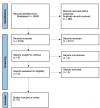Conservative vs Surgical Treatment of Anterior Cruciate Ligament Rupture: A Systematic Review
- PMID: 38646275
- PMCID: PMC11027445
- DOI: 10.7759/cureus.56532
Conservative vs Surgical Treatment of Anterior Cruciate Ligament Rupture: A Systematic Review
Abstract
Anterior cruciate ligament (ACL) injury is very common, especially in young athletic individuals who injure themselves during sports involving pivoting actions. Management options include conservative management, which involves progressive physical therapy, educating the patient on how to prevent instability, and the use of a hinged knee brace. Surgical management involves reconstruction of the torn ligament using an autograft or an allograft and ACL repair where the torn ligament is affixed back to the tibia or femur. The choice of management depends on the severity of the injury, other injuries in associated structures, the level of fitness, and the athletic goals of the patient. Many studies exist on the management choice of ACL injury, but no clear consensus prevails. This study will examine the effectiveness of conservative versus surgical management. A literature review will be performed to identify appropriate papers which compare and evaluate the two approaches. A literature search for randomized controlled trials (RCTs) and cohort studies comparing the conservative to surgical management of ACL injury was conducted on PubMed, Scopus, and Web of Science. Patient eligibility criteria included individuals older than 15 with an isolated, recent ACL injury diagnosis via an appropriate clinical test, MRI, or arthroscopy. Studies were eligible if they were using appropriate surgical or conservative methods, as mentioned previously, and measuring results via appropriate scores, tools, and methods that will be presented below. The follow-up timeline would be from presentation time until at least two years. Five papers were found to be eligible. Overall, these papers included 462 patients. Two studies measuring overall knee symptoms, function, and sports activities using the International Knee Documentation Committee Subjective Knee Form (IKDC) score found that the operated group had a significantly higher score. The other two studies measured overall knee function and health using the Tegner & Lysholm and Knee Injury and Osteoarthritis Outcome Score (KOOS) scores. In both papers, no significant difference was found between the two groups. Regarding Tegner's activity score, only one paper had significant findings. A significantly longer period to return to sports activities was observed in the operative group. Stability was significantly higher in all papers in the operated group. Osteoarthritis was measured using different tools in each paper. Only one paper found a significantly higher risk in the operated group. Only one paper indicated significantly more complications in the operated group regarding side effects. Overall, very few differences were observed between the two treatment groups. The most significant differences observed were the higher stability and the longer recovery period in patients undergoing surgery. Large RCTs following patients for enough time are needed to prove if surgical treatment offers significant benefits over conservative treatment.
Keywords: acl rehabilitation; acl repair; anterior cruciate ligament (acl); anterior cruciate ligament injury; conservative vs surgical management; systematic literature review.
Copyright © 2024, Papaleontiou et al.
Conflict of interest statement
The authors have declared that no competing interests exist.
Similar articles
-
Early Operative Versus Delayed or Nonoperative Treatment of Anterior Cruciate Ligament Injuries in Pediatric Patients.J Athl Train. 2016 May;51(5):425-7. doi: 10.4085/1062-6050.51.5.11. Epub 2016 May 31. J Athl Train. 2016. PMID: 27244126 Free PMC article. Review.
-
Long-term Outcomes of Primary Repair of the Anterior Cruciate Ligament Combined With Biologic Healing Augmentation to Treat Incomplete Tears.Am J Sports Med. 2018 Dec;46(14):3368-3377. doi: 10.1177/0363546518805740. Epub 2018 Nov 6. Am J Sports Med. 2018. PMID: 30398894
-
[Return to sports WeChat applet for evaluating the rehabilitation effects after anterior cruciate ligament reconstruction].Zhongguo Xiu Fu Chong Jian Wai Ke Za Zhi. 2023 Sep 15;37(9):1086-1093. doi: 10.7507/1002-1892.202305021. Zhongguo Xiu Fu Chong Jian Wai Ke Za Zhi. 2023. PMID: 37718420 Free PMC article. Clinical Trial. Chinese.
-
Effect of graft choice on the outcome of revision anterior cruciate ligament reconstruction in the Multicenter ACL Revision Study (MARS) Cohort.Am J Sports Med. 2014 Oct;42(10):2301-10. doi: 10.1177/0363546514549005. Am J Sports Med. 2014. PMID: 25274353 Free PMC article.
-
Nonoperative Management, Repair, or Reconstruction of the Medial Collateral Ligament in Combined Anterior Cruciate and Medial Collateral Ligament Injuries-Which Is Best? A Systematic Review and Meta-analysis.Am J Sports Med. 2024 Feb;52(2):522-534. doi: 10.1177/03635465231153157. Epub 2023 Mar 24. Am J Sports Med. 2024. PMID: 36960920
Cited by
-
Comparison of Surgical and Non-Surgical Treatment of Anterior Cruciate Ligament Injury in Middle-Aged Population: A Prospective Cohort Study.Cureus. 2025 May 20;17(5):e84489. doi: 10.7759/cureus.84489. eCollection 2025 May. Cureus. 2025. PMID: 40539191 Free PMC article.
References
-
- The anterior cruciate ligament and functional stability of the knee joint. Liu-Ambrose T. https://bcmj.org/articles/anterior-cruciate-ligament-and-functional-stab... B C Med J. 2003;45:495–499.
-
- Incidence of anterior cruciate ligament injury and other knee ligament injuries: A national population-based study. Gianotti SM, Marshall SW, Hume PA, Bunt L. J Sci Med Sport. 2009;12:622–627. - PubMed
-
- Evans J, Mabrouk A, Nielson Jl. Orthoinfo. Treasure Island (FL): StatPearls Publishing; 2023. Anterior Cruciate Ligament Knee Injury. - PubMed
-
- Prospective trial of a treatment algorithm for the management of the anterior cruciate ligament-injured knee. Fithian DC, Paxton EW, Stone ML, Luetzow WF, Csintalan RP, Phelan D, Daniel DM. Am J Sports Med. 2005;33:335–346. - PubMed
Publication types
LinkOut - more resources
Full Text Sources

